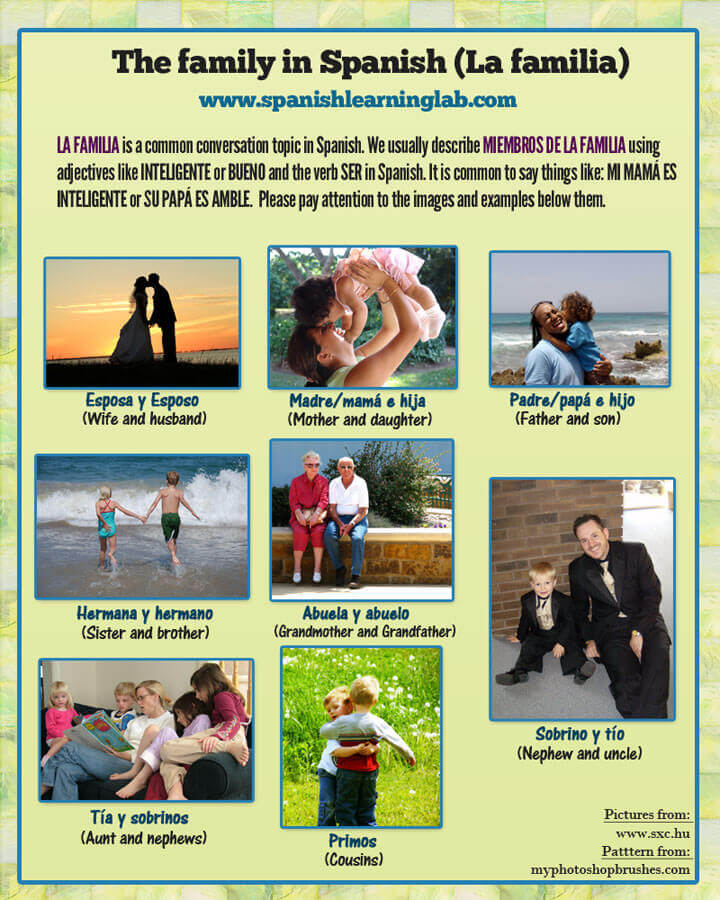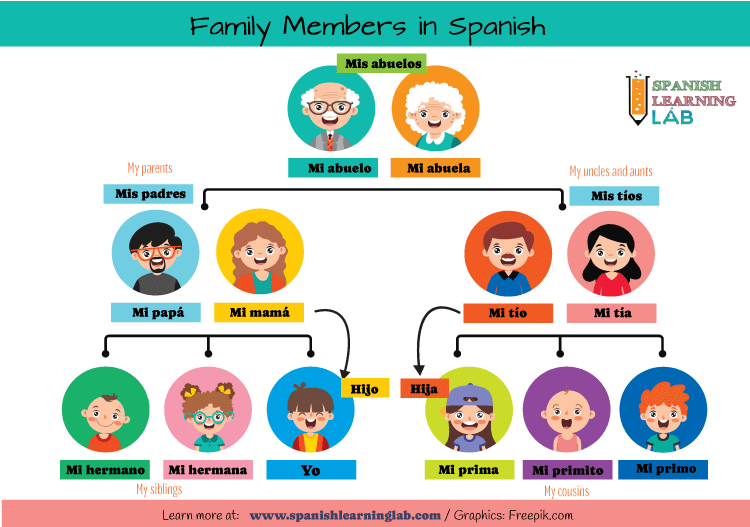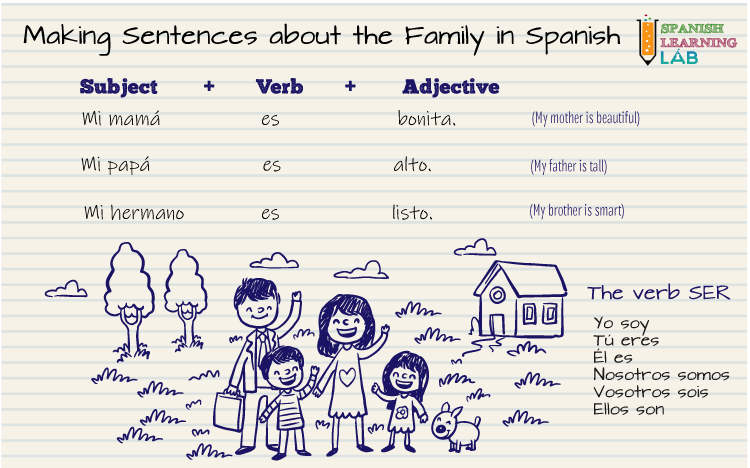Do you know how to say the most common family members in Spanish? There are so many relatives and we could simply write a long list with all of them, but making list of words is not how you learn a language. Instead, this lesson will teach you the ones you will use the most in real situations, and more importantly, the grammar structures and verbs needed to make meaningful sentences with family members. “¡Comencemos!”

Introductory video: Common Family members in Spanish
Let’s begin by watching a video showing a list of family members in Spanish and how they should be written and pronounced. This video teaches words such as Mamá (mom) and Abuelito (grandpa) and explains some key things about the verbs SER (to be) and TENER (to have) and the right way to use them to describe family members, which is the central topic of our next lesson. Try to stick until the end of the video as it will definitely help you understand all the examples presented in the rest of the lesson.
Talking about family members in Spanish
Family relationships in Spanish and jobs
First, in order to talk about family relationships in Spanish, we will use possessive adjectives. They are words like MI (my) and SU (your) that can be used as in “Mi mamá”(my mother). The possessive adjective to use must agree in number and gender with the family member. For instance, to talk about “my brother” I should say “Mi hermano”, but if I mean to say “my brothers” then I should use MIS instead of MI as in “Mis hermanos”. As you can see, possessive adjectives are really important to talk about relationships between family members in Spanish.
The way to call some family members in Spanish
Some family members can be called in two ways such as “Mamá”/”Madre” and “Papá”/”Padre”. “Mamá” and “Papá” are way more casual. Notice that these two words need tilde in the last vowel, else they will mean something else. The word “PADRES”, which is also the plural form of father in Spanish, will be used meaning “parents”. Also, there is a cute way to call grandparents by adding the suffix -ITO at the end as in “Abuelito” (grandpa) and “Abuelita”(grandma). This termination can also be added to “Mamá” and “Papá” to say “Mamita” and “Papito”.

How to describe family members in Spanish and say what they do
The easiest way to describe things and even family members in Spanish is by using the irregular verb SER. Basically, SER can be used as ES for one person, e.g. “Mi papá es…” (My dad is…) and SON for several relatives as in “Mis tíos son…” (My uncles are…). After the verb SER, we need to place an adjective such as “trabajador” (hard-working) or “amable” (kind), or even job titles and occupations like “Ingeniero” (Engineer). Moreover, you can use adverbs like “MUY” (very) to make adjectives stronger.
The chart below contains sentences with a list of common family members in Spanish. Here, you will see both possessive adjectives to express family relationships and SER + Spanish adjectives to describe relatives the easy way. Click on Play to listen to the sentences.

|
Su esposo es ingeniero
Her husband is an engineer
|
|
Mi esposa es ama de casa
My wife is a housewife
|
|
Sus padres son estrictos
Her/His/Their parents are strict
|
|
Madre (formal)/Mamá(informal) – Mi mamá es muy inteligente
My mom is very intelligent
|
|
Padre (formal)/ Papá(informal) – Su papá es muy práctico
His/Her father is very practical
|
|
Nuestra hija es linda
Our daughter is beautiful
|
|
Nuestro hijo es creativo
Our son is creative
|
|
Su hermano es doctor
Her/His brother is a doctor
|
|
Su hermana es enfermera
Her sister is a nurse
|
|
Nuestros abuelos están casados
Our grandparents are married
|
|
Abuelo / abuelito – Mi abuelo es un anciano my enérgico.
Grandpather/grandpa – My grandfather is an energetic old man
|
|
Abuela / abuelita – Mi abuela es muy cariñosa
Grandmother/grandma – My grandmother is very affectionate
|
|
Sus nietos son traviesos
Her grandchildren are naughty
|
|
Su nieto es apenas un bebe
His grandchildren is still a baby
|
|
Mi nieta es muy bonita
My granddauther is very beautiful
|
|
Mis tíos son muy divertidos.
My uncles and aunts are very fun
|
|
Hijos/Niños – Los hijos de María son adorables
Maria’s children are adorable
|
|
Nuestra madrastra es buena.
Our step-mother is good
|
|
Mi padrastro es muy amable.
My step-father is very kind
|
|
Mi suegra es muy enojada
My mother in law is angry
|
Introducing family members in Spanish
Sometimes you will also need to introduce a relative in Spanish. To do so, you can use this sentence structure:
Relative + SE LLAMA + Name as in “Mi mamá se llama Teresa”
You can also refer to someone else’s relatives by using SER and possessive adjectives to state the relationship as in SU HIJA (her daughter) . Here are some examples of sentences introducing family members in Spanish
|
Mi tía se llama Ana
My aunt’s name is Ana
|
|
Su suegro se llama Juan
My father-in-law’s name is Juan
|
|
Ella es mi cuñada
She is my sister-in-law
|
|
Él es nuestro cuñado
He is our brother-in-law
|
|
Él es su yerno
He is her son-in-law
|
|
Ella es su nuera
She is her daugther-in-law
|
Sharing information about your relatives in Spanish
In addition to describing your relatives and introducing them to other people, you can also share information about them such as the place where they live, their age, how many children they have and so on. Below there is a last group of sentences with family members in Spanish sharing personal information. Make sure to practice with the quiz at the end of the lesson once you check all the examples. We hope you find the examples provided in the lesson very useful. ¡Hasta pronto!
| El bebé de Ana está saludable Ana’s baby is healthy |
|
Mi tío vive en California
My uncle lives in California
|
|
Ella tiene muchos sobrinos
She has many nephews
|
|
Mi sobrina tiene 10 años.
My niece is 10 years old
|
|
Yo tengo cinco primos.
I have five cousins
|
|
Mi prima es de Argentina
My cousin (girl) is from Argentina
|
|
Su primo es de Alemania
His cousin (boy) is from Germany
|
Related Spanish Worksheets:
- Family Tree in Spanish (Vocabulary)
- Family Members in Spanish (Tree + Sentences)
- Questions about the Family in Spanish (Speaking)
- Making Questions in Spanish (Speaking)
- Family Relationships in Spanish (Reading)
- Dialogues about the family in Spanish
- Introducing my Family in Spanish (Reading)
